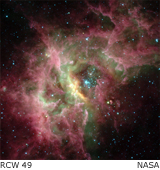Professor

Harriet Dinerstein

Office: RLM 16.324
Hours: M 1:30-2:30, W 10:30-11:30, or by appt
Phone: (512) 471-3449
email
Course Website

TA

Rongfeng Shen
TA

Daungruthai
Jarukanont
("Kanon")
|
 |
Syllabus for printing
-
pdf
COURSE DESCRIPTION: Welcome to Astronomy 301! This course will provide a one-semester
introduction to the universe around us, from our own Solar System to stars, galaxies, and the largest
scales of space and time. Since our goal is to paint the "big picture," it will be a bit of a whirlwind tour,
but - as you will see - there are many connections from small to large scales. We will also discuss how
astronomers determine such seemingly impossible-to-know things as distances to stars, masses of
planets orbiting other stars, and what the universe was like, long ago.
TEACHING PHILOSOPHY: Since you are not science/engineering majors (if you are, you should take Ast 307!),
our main emphasis will be on conceptual understanding. However, just to express the vastness of space or smallness
of subatomic particles quantitatively, it is necessary to use "scientific notation" (powers of ten). In addition, in order to
understand how properties of astronomical objects are related to each other, we need to use ratios and proportionality.
There will be simple mathematical calculations on homeworks, but we will provide help if needed (see "Getting Help").
TEXTBOOK: I have chosen the latest (Fourth) edition of "The Cosmic Perspective," by Bennett, Donahue, Schneider,
and Voit. You will have to buy a new copy, since this edition has literally just come out (in the last few weeks). While there
are several older and alternate textbooks by Bennett and his team, I do not recommend using them, for several reasons.
The alternate versions omit some material you will need this semester (e.g. some of the alternate editions do not include
the Solar System section, or stars and galaxies), or are organized differently so that the chapter and problem numbers
do not correspond. Many illustrations and animations used in class will be from this edition, and I will sometimes assign
homework problems from the directly from the book. In addition, the book comes with an access code that is required to
access a variety of useful (and fun!) tools at the publisher's website. These include tools such as interactive animations
organized into self-paced tutorials, practice quizzes, and other helpful supplementary materials.
|

